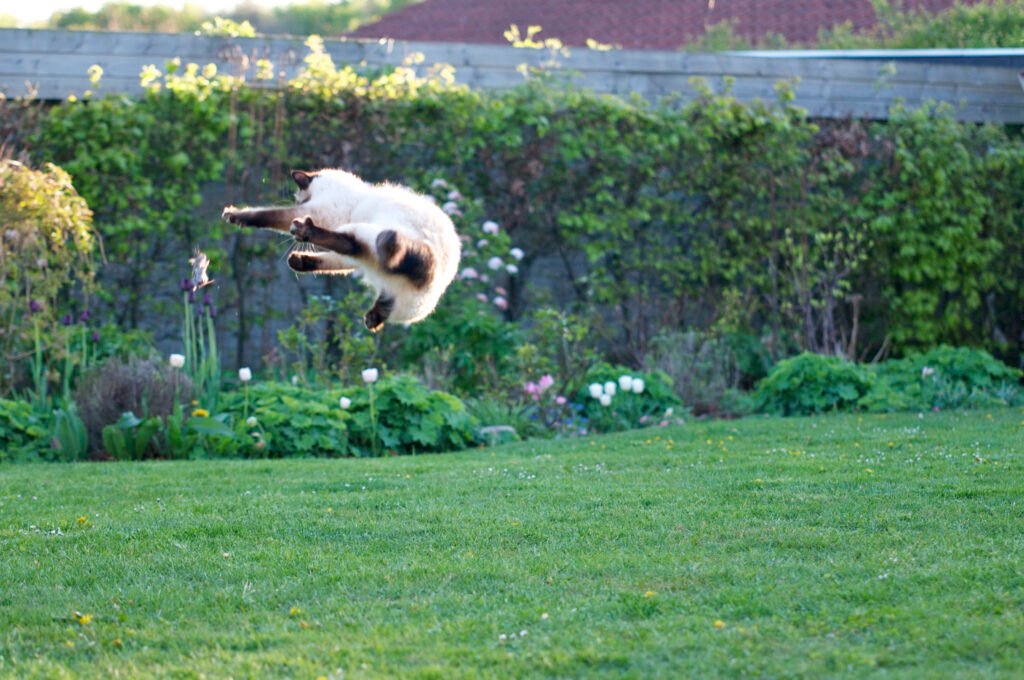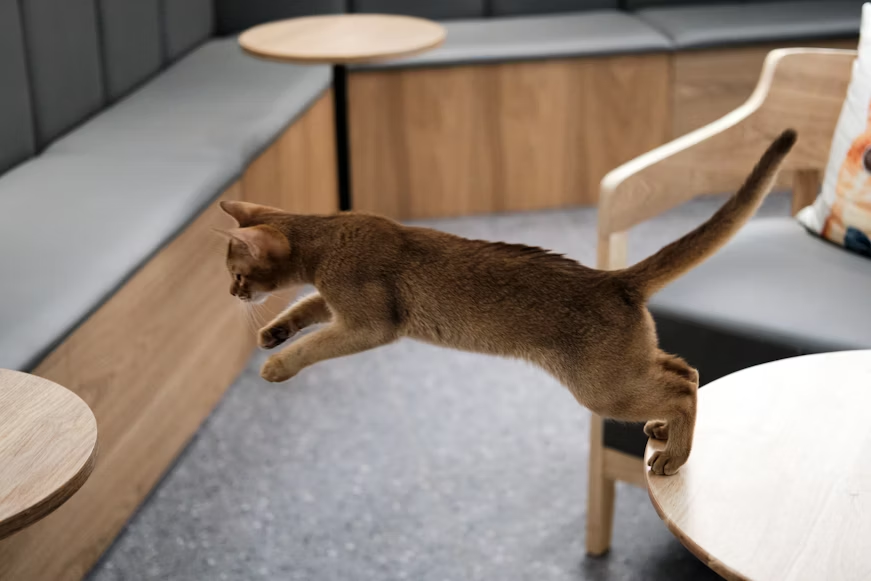There’s a moment – half gasp, half awe – when a cat slips and time seems to stretch. The animal tumbles, twists, and somehow touches down with a soft thud, eyes bright, dignity intact. For more than a century, that miracle has teased physicists and veterinarians alike: how does a cat flip in midair with nothing to push against? What looks like magic is, in fact, a master class in physics, anatomy, and split‑second timing. And once you see the hidden choreography, you’ll never watch a cat the same way again.
The Hidden Clues

Ever watch a slow-motion clip and feel as if the cat is solving a puzzle faster than you can blink? That’s because the righting reflex is not a single trick but a cascade: sense, plan, rotate, and land. The body reads the world in micro-slices of time, stitching them into a decision about which way is down and how to get there safely.
Under the fur, a flexible spine and floating shoulder blades give the torso room to twist without tearing muscle. The cat spreads its limbs like a small parachute, then reshapes its body midair to guide the fall. It’s part physics, part design – an elegant duet between what the cat knows and what its body can do.
A Built-In Gyroscope: The Vestibular Advantage

At the core of that first decision – what’s up, what’s down – is the inner ear. Fluid-filled canals inside the skull register head rotation and acceleration, feeding the brain a rapid-fire stream of orientation data. Think of it like a biological gyroscope that never needs batteries and updates faster than any smartwatch.
Vision quietly backs this up, stabilizing the gaze and refining estimates of distance as the ground approaches. Whiskers add a near-field sense of the environment once the cat is close enough to feel air currents and surfaces. Together, these systems fuse into a stable “down” signal that kicks off the righting reflex before panic even has a chance to arrive.
The Twist Without a Push: Two-Part Rotation

Here’s the head-scratcher: in empty space, you can’t just spin out of nowhere. Cats get around this by twisting their bodies in two segments, changing shape to shuffle angular momentum between front and rear halves. The front tucks while the rear extends, then they swap, letting the torso rotate without any external push.
It’s like watching a skilled diver turn with a subtle tuck and flare, except the cat runs this routine twice, quickly, and in midair. The flexible spine acts as the hinge for that coordination, making a controlled twist possible in a fraction of a second. No magic, just conservation laws used with unbelievable finesse.
The Tail Myth, Explained

People love to credit the tail for every aerodynamic miracle, but the truth is more modest. Tails are superb for balance on narrow ledges and for fine-tuning rotation, yet cats without tails still right themselves reliably. The heavy lifting happens through limb position, spinal bend, and the two-part twist.
Where the tail shines is in micro-adjustments when the fall isn’t straight or when the cat needs that last sliver of control. It acts like a trim tab on a small plane, nudging the body where it needs to go. Helpful, yes; essential, no – and that’s a testament to how much the rest of the body already brings to the table.
Shock Absorbers: Paws, Spine, and Flex

Landing is its own science. The cat aims to meet the ground with forepaws first, elbows bent, head high, and back arched, turning a jolt into a rolling, springy absorption of force. Muscles and tendons act like layered suspension, bleeding off energy stage by stage instead of in one destructive punch.
The paw pads cushion the first contact, while joints flex progressively to spread loads across the limbs and spine. That arch you see is not drama – it’s a deliberate way to keep forces away from vulnerable organs. The result is a landing that looks soft because the impact is being managed in a dozen tiny, coordinated steps.
From Ancient Tools to Modern Science

Long before high-speed cameras fit in pockets, early motion pioneers filmed cats falling to decode the righting reflex frame by frame. Today, researchers use faster cameras, 3D motion capture, and computer models to track joint angles and timing with millisecond precision. The math reads like a dance score: when to tuck, when to extend, how much to arch.
Engineers then recreate the trick in robot prototypes, testing segmented bodies that can twist without external torque. Even drop towers and controlled free-fall rigs are in the mix, because gravity is the most honest lab partner you can get. Each upgrade sharpens the picture of how agility and physics fuse in midair.
Why It Matters

Understanding cat righting isn’t trivia; it’s a blueprint for stability in a chaotic world. Drones that self-correct in turbulent air, delivery bots that recover from bumps, and wearable devices that predict falls can all borrow from feline playbooks. A cat’s approach – sense first, reshape, then absorb – translates neatly into sensor fusion, adaptive control, and soft-landing design.
It also reframes household safety with empathy rather than fear. I once watched a neighbor’s cat misjudge a balcony rail; it landed fine, but the slip was a wake-up call about screens, ledges, and toys that trigger risky leaps. When we understand the limits of this reflex, we stop testing it and start designing around it.
Global Perspectives

Street cats in dense cities, desert-adapted mousers, and rural barn companions all face different fall risks and surfaces. Urban felines navigate slick metal and glass, while country cats deal with cluttered haylofts and uneven ground. The righting reflex is the same, but the environment sets the exam and writes the trick questions.
Breed differences in body length, mass, and tail shape may tweak how the reflex plays out, yet the core choreography stays surprisingly consistent. Even aging or heavier cats show the sequence, though speed and range of motion can narrow. In other words, biology supplies the script – and the setting decides the lighting and stage.
The Future Landscape

Expect engineers to push deeper into cat-inspired control for micro-drones, camera gimbals, and rescue robots that can flip themselves upright. New materials in soft robotics will let machines flex spines and “float” shoulders the way cats do, turning jolts into controlled motion instead of damage. Onboard AI can mirror the cat’s decision pipeline: detect, predict, reconfigure, land.
Veterinary teams may adopt finer motion analysis to guide rehab for balance disorders and injuries. Consumer tech could quietly inherit safer-fall designs for phones, wearables, and even furniture that yields on impact. The big frontier isn’t just copying the trick – it’s importing the strategy of sensing and reshaping in real time, with ethics baked in from the start.
Conclusion

The cat’s midair flip isn’t a party trick – it’s a physics engine wrapped in fur, guided by exquisite senses and an agile mind. From ear canals to paw pads, every part is tuned to turn panic into poise. The lesson for us is bigger than a soft landing: sense clearly, adapt quickly, and spread impact across what can bear it.
Once you see the sequence, you start spotting it everywhere – in clever machines, in better buildings, in safer habits at home. The next time a cat tumbles and plants its feet, ask yourself: what in my world could use that kind of graceful correction?

Suhail Ahmed is a passionate digital professional and nature enthusiast with over 8 years of experience in content strategy, SEO, web development, and digital operations. Alongside his freelance journey, Suhail actively contributes to nature and wildlife platforms like Discover Wildlife, where he channels his curiosity for the planet into engaging, educational storytelling.
With a strong background in managing digital ecosystems — from ecommerce stores and WordPress websites to social media and automation — Suhail merges technical precision with creative insight. His content reflects a rare balance: SEO-friendly yet deeply human, data-informed yet emotionally resonant.
Driven by a love for discovery and storytelling, Suhail believes in using digital platforms to amplify causes that matter — especially those protecting Earth’s biodiversity and inspiring sustainable living. Whether he’s managing online projects or crafting wildlife content, his goal remains the same: to inform, inspire, and leave a positive digital footprint.




